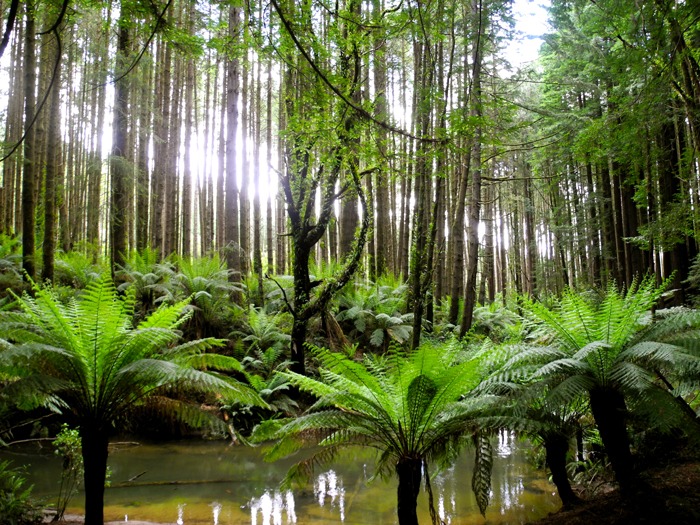
How Forests Could Bridge the Energy Transition (Op-Ed)

Richard Houghton is a senior scientist at the Woods Hole Research Center, an independent research institute where scientists investigate the causes and effects of climate change to identify and implement opportunities for conservation, restoration and economic development. Houghton contributed this article to Live Science's Expert Voices: Op-Ed & Insights.
Negotiators in Paris face a tough job hammering out a global agreement to slash greenhouse gas emissions far enough and fast enough to prevent the worst effects of climate change. But a fresh look at forests might reveal a solution.
If governments could reverse tropical deforestation, the planet could buy some time, a point my colleagues and I highlighted in a recent commentary in the current issue of Nature Climate Change. Management of tropical forests could stabilize current CO2 concentrations while nations transition from fossil fuels to clean, renewable energy. [Study Shows, for Chile, Renewables Benefits Outweigh Costs (Op-Ed )]
It's a matter of time
Climate negotiations have revolved around limiting global warming to an increase of between 1.5 and 2 degrees Celsius (2.7 to 3.6 degrees Fahrenheit). To do that requires stopping the use of fossil fuels, and quickly, because once CO2 enters the atmosphere, its warming effect lasts for centuries.
Can governments act quickly enough? It will be difficult if they rely solely on transitioning from fossil to renewable fuels. But the world's vast tropical forests can help, by withdrawing large amounts of carbon from the atmosphere, emissions that would otherwise contribute to climate change. Management of tropical forests could withdraw as much as 3 billion metric tons of carbon, about 30 years' worth of current carbon emissions.
Forests' carbon-storing abilities cannot compare to the potential emissions in the planet's current fossil fuel reserves. But the value of forests is clearer when you compare their climate-stabilizing potential to the emission cuts that would be necessary to avoid a warming of 2 degrees Celsius. It then becomes clear that forests are capable of balancing the scales while the world completes its clean-energy transition.
Sign up for the Live Science daily newsletter now
Get the world’s most fascinating discoveries delivered straight to your inbox.
Scientists often explain that deforestation contributes about 10 percent of the world's global greenhouse gas emissions each year. But that statistic obscures the unique role forests play in the climate. When farmers clear forests for agriculture, and when you account for other sources of emissions like soil tilling, deforestation sends 4 billion metric tons of carbon into the atmosphere each year. But trees and soil also absorb carbon from the atmosphere, to the tune of 3 billion metric tons a year.

Thus, net emission from deforestation are "just" 1 billion metric tons a year, which can seem relatively small compared to the 9 billion metric tons of emissions from fossil fuel burning. But based on the raw amount of emissions going into the atmosphere, forests remain a major player, not a minor one, in the global climate system.
If climate leaders could change the dynamics that drive deforestation — if they could get farmers on the edge of the world's vast tropical forests to stay on the same land, keep remaining forests intact and allow cleared areas that aren't being used to grow back — the carbon storage potential is truly impressive.
Not only would that stop 4 billion metric tons of emissions from going into the atmosphere, it would also mean the world would continue to enjoy the benefits of forests and lands absorbing carbon from the atmosphere. Additional policies aimed at reforestation could lead to another billion tons of emissions being stored in forests instead of the atmosphere. Such a scenario would cut total global emissions in half, from 10 billion metric tons today to 5 billion metric tons. [Momentum Builds for Deforestation-Free Palm Oil (Op-Ed )]
And people wouldn't have to do it forever. Once the world stops emitting vast amounts of greenhouse gases, the forests' role as carbon sink becomes less important. Truly sustainable forestry becomes a lot easier in an age of clean energy and low emissions.
Moving off of fossil fuels might sound unrealistic to some. But the truth is that releasing 10 billion metric tons of carbon dioxide into the atmosphere every year, as the world does now, is unrealistic. It is not sustainable. It needs to change.
A serious forest strategy would help negotiators get a climate deal done — and make it easier for countries to deliver on their climate promises.
Follow all of the Expert Voices issues and debates — and become part of the discussion — on Facebook, Twitter and Google+. The views expressed are those of the author and do not necessarily reflect the views of the publisher. This version of the article was originally published on Live Science.









